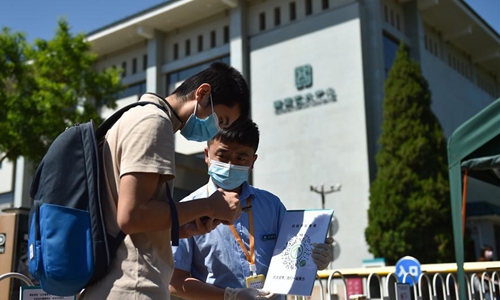
A staff member helps a visitor scan a QR code to present personal health code at the National Library of China in Beijing, capital of China, May 12, 2020. The southern area of the National Library of China reopened to the public on Tuesday. Visitors need to make reservations via the social media application Wechat or phone calls, according to a notice from the library. (Xinhua/Chen Zhonghao)
Since the COVID-19 outbreak, I have added a special communication to my morning routine. I would text two words about my location and health status - Beijing, healthy - in an online group of my colleagues on WeChat, China's social networking app. This has become my daily practice for over 100 days now.
Since the outbreak, nearly 4 million community workers in urban and rural neighborhoods across China have been collecting data every day. Their updated reports every 24 hours have enabled the country with 1.4 billion people to extract valuable information for COVID-19 control in real time.
To curb the spread of the highly contagious novel coronavirus, the Chinese government has introduced extensive quarantine measures, rigorous health checks, and unprecedented data reporting synergy. Using digital tools like big data and artificial intelligence (AI) has become key to turning the tide.
National and local authorities are working closely with large technology companies like China's e-commerce platform Alibaba, technology company Tencent, and search engine Baidu to innovate smart application solutions for relevant diagnoses, monitoring, forecasts, security checks, healthcare, work resumption, and even avoidance of panic buying.
Mobile phone data has been used to track users' daily locations and health status. Community workers have innovative apps and mini programs to improve their work efficiency. Thanks to the apps and online programs, they inform people where they can get masks or delivered food, or how many people returned home from travel, and where they came from. They also can tell whether new returnees traveled on the same flight or train with the confirmed or suspected COVID-19 patients.
Upon their arrival, returnees must first register at their neighborhood center and get a paper or electronic pass. By simply scanning a QR code on their smartphones, information over their whereabouts for the past 14 days can be shown. Their information is registered in a database for checking whether they've fulfilled quarantine requirements.
Some Chinese high-tech companies are now providing free AI and big data analysis services for the public.
Alibaba's global research program DAMO (Discovery, Adventure, Momentum, and Outlook) Academy used a gene sequencing AI algorithm to reduce the time of COVID-19 sample genome analysis from several hours to just half an hour. This technique has greatly improved diagnostic efficiency. In addition, DAMO's AI-enabled medical-imaging work has been used in 168 Chinese hospitals, including Wuhan's Huoshenshan, a makeshift hospital built in 10 days in response to the deadly virus. DAMO has also provided free access to global medical institutions in the viral struggle.
Baidu and MEGVII, a Chinese AI company, have developed a AI-powered fever detection system, which use infrared and facial recognition technology to scan more than 200 people every minute in public transportation venues. If a passenger appears with a temperature of 37.3 C or above, an alert will be issued.
An app dubbed "Close Contact Detector," jointly developed by the General Office of the State Council, the National Health Commission, and China Electronics Technology Group Corporations, enables people to check whether they were in close contact with someone infected.
By integrating data collected from both public and private sectors, China has used blockchain technology to automatically generate accurate data reports. This high technology has helped reduce cross-infections and death tolls. It has also allowed the public to learn about risks of infection they might have been exposed to in a timely manner so they can take appropriate actions.
Moreover, it enables authorities to make scientific decisions, thus optimizing resource allocations and for quickly evaluating follow-up effects of emergency policies.
A sincere display of respect for life unites all Chinese people and strengthens their endorsement of data reporting in the spirit of collectivism.
By using high technology at the cost of short-term restricted mobility, the Chinese people have built up a solid "Great Wall" against the rampant spread of the virus. With the arrival of the summer of 2020, China has primarily controlled the spread of COVID-19. Only a shared vision and collective action can further save humanity from this global catastrophe.
The author is an associate professor from Beijing Foreign Studies University. opinion@globaltimes.com.cn

